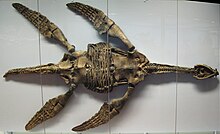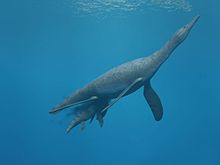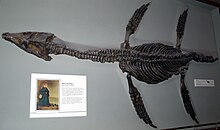Plesiosaurs
| Plesiosaurs | ||||||||||||
|---|---|---|---|---|---|---|---|---|---|---|---|---|

Live artistic representation of Plesiosaurus |
||||||||||||
| Temporal occurrence | ||||||||||||
| Rhaetium ( Upper Triassic ) to Maastrichtian ( Upper Cretaceous ) | ||||||||||||
| 208.5 to 66 million years | ||||||||||||
| Locations | ||||||||||||
|
||||||||||||
| Systematics | ||||||||||||
|
||||||||||||
| Scientific name | ||||||||||||
| Plesiosauria | ||||||||||||
| de Blainville , 1835 |
The plesiosaurs ( Greek πλησίος plēsíos "near, almost"; σαύρα saúra "lizard": almost lizards) are a group of extinct reptiles that lived in the sea from the late Upper Triassic to the end of the Cretaceous and became extinct at the same time as the dinosaurs are.
As sea creatures, they had an elongated body and four paddle-shaped fins. Like today's lizards and snakes, they belonged to the lepidosauromorpha and are divided into two distinctly different taxa : the long-necked and small-headed actual plesiosaurs (Plesiosauroidea) and the pliosaurs (Pliosauroidea), for which a short, powerful neck and a large head with a long snout is characteristic.
description

Plesiosaurs were 3 to 15 meters long, but there are also previously undescribed fossils that suggest a maximum length of more than 20 meters (" Monster of Aramberri "). All plesiosaurs had a short body in the form of a flattened spindle and a relatively short tail, which could be provided with a tail fin for control. The cervical spine of the real plesiosaurs is greatly elongated (up to 72 vertebrae) and mobile, the skull is very small in comparison and the teeth are homodontic (uniform). In contrast, the pliosaurs have a short cervical spine (advanced forms with only 13 vertebrae) and a relatively large skull (up to 4 meters in length), with a set of teeth that is heterodontic to a certain extent, that is, it exists teeth of different sizes, which also differ slightly in terms of shape (tooth morphology). The legs were transformed into paddle-shaped fins.
Like the ichthyosaurs and mosasaurs , the plesiosaurs are said to have been able to keep their body temperature at a constant high level of at least 33 ° C ( endothermia ).
Way of life
Locomotion
Plesiosaurs used to be believed to have rowed their fins. Rowing is a method of locomotion that is based on the fact that the water resistance is used to push yourself forward in the water. On the one hand, the legs must have a larger area (which is the case with plesiosaurs), on the other hand, straight edges and corners are favorable, because they create water eddies that increase water resistance. A good example of a rowing limb are duck feet, which are webbed and have claws. The fins of the plesiosaurs, on the other hand, have a shape that is more like a wing, they converge at the end and have a teardrop-shaped cross-section. In addition, plesiosaurs have greatly enlarged chest and pelvic bones to which large muscles have attached. This together strongly suggests that plesiosaurs practiced underwater flight. This locomotion is used today by penguins , sea turtles and otters and works in principle like flying in the air. Due to the shape of the paddles, different pressure conditions are generated below and above the paddle, which are used for movement. Moving the paddles in the water takes a lot of strength, hence the large muscles.
Even if some animals living today fly under water, they can only be compared to the plesiosaurs to a limited extent, because they only ever use the front extremities. In the plesiosaurs, on the other hand, the fore and hind limbs are well developed and most likely both were used. The exact coordination of the legs - that is, whether all four were moved at the same time, or alternately in front, then in back, or left in front at the same time as right in back and vice versa - is unknown. It is also likely that the mode depended on the speed.
Plesiosaurs and pliosaurs differ slightly in the shape and relative size of the paddles, suggesting that they moved differently. Originally it was assumed that pliosaurs were capable of short, powerful and fast accelerations as ambulance hunters, while the plesiosaurs had moved at a moderate speed, but were very persistent. Recent comparisons of plesiosaur fins with bird wings suggest that it was rather the other way around. However, the comparison of fins with wings is not entirely undisputed in science.
nutrition
Plesiosaurs believed to have a wide variety of foods. What they all have in common is that they were carnivores - the teeth of plesiosaurs do not indicate plant food. Many plesiosaurs were probably fish-eaters, the larger pliosaurs, on the other hand, probably also hunted squid , ammonites , sharks , ichthyosaurs and smaller plesiosaurs in a more versatile manner. Squid remains have been found in the stomach of plesiosaurs, and bite marks that could belong to pliosaurs have been found on the leg bones of smaller plesiosaurs. Plesiosaurs were also hunted themselves , the remains of a plesiosaur were found in a very large mosasaur from the Cretaceous North America.
The long neck of the plesiosaurs certainly played a major role in food intake. The neck is not as flexible as it appears. Movement upwards was only possible to a very limited extent, as well as to the sides, the mobility downwards was best. Plesiosaurs could not curve their necks into an "S" as it is often depicted. The good downward mobility could mean that plesiosaurs not only hunted but also picked up food such as ammonites, clams , crabs and other smaller animals from the sea floor .
Many plesiosaurs have been found with stomach stones . Some birds also have stomach stones that grind up food in the stomach. Birds do not have teeth and therefore cannot chew as well as mammals . A similar function is assumed by the stomach stones of the dinosaurs. In the case of plesiosaurs - like crocodiles , which also have swallowed stones in their stomachs - it is not certain whether they were used to chop up food or to compensate for the buoyancy of the air-filled lungs.
On the basis of fossils of the 15-meter-long plesiosaur Predator X ("Monster of Spitzbergen") discovered by the paleontologist Jørn H. Hurum on the Norwegian Arctic island of Spitzbergen in 2008 , a bite force of 147 kilonewtons was calculated. This is one of the highest jaw forces in the animal kingdom.
Reproduction

For a long time, the reproduction of the plesiosaurs was poorly known. Since these are reptiles, it was natural to assume that these animals laid eggs. Reptile eggs must be laid ashore, such as B. in turtles, and the plesiosaurs were so adapted to marine life that it is unclear whether they ever came near land or were even able to do so. Stranded whales die because their skeleton cannot support them adequately without the buoyancy in the water, which compresses the lungs and suffocates the animals. Since the skeleton of plesiosaurs has also adapted to the conditions in the water, it is conceivable that they had a similar experience when they went ashore.
There have been finds of ichthyosaurs and mosasaurs whose fetuses are preserved in the womb, which directly proves that these animals were also viviparous. Something similar is known of Keichousaurus , Lariosaurus and Neusticosaurus , distant relatives of the plesiosaurs, and since 2011 also of a plesiosaur: the skeleton of a not yet fully developed young animal discovered in the abdomen of a 78 million year old fossil of Polycotylus latippinus was 1.5 in length m already a third as tall as his 4.70 m long mother. Plesiosaurs therefore probably only gave birth to a single, relatively large young animal for which they cared for breeding, similar to the whales today . Very large species such as Kronosaurus , Elasmosaurus or Liopleurodon were certainly unable to come ashore to lay their eggs because of their enormous mass, which in turn inevitably caused the birth of living young.
Systematics and phylogeny
External system and origin
Plesiosaurs appear in the uppermost Triassic . The first genera include Thalassiodracon , Macroplata and Microcleidus , the last two from the Rhaetium ( Thalassiodracon ) and Hettangium of Great Britain. They belong to a group of swimming dinosaurs, the sauropterygians , which has been known since the Lower Triassic .
Sauropterygians come in many different forms: some are very small, others larger and probably lived like crocodiles, and still others specialized in mussels as food. All of these forms lived near the coast and were not as adapted to life in the open ocean as the plesiosaurs. The relationships between the Sauropterygians and other reptiles are unclear, as is the exact ancestors of the plesiosaurs within the Sauropterygians. The closest relative is considered to be Pistosaurus and related forms known from the Upper Triassic of Europe and North America.
The plesiosaurs themselves are divided into two large groups: pliosaurs and plesiosaurs in the narrower sense.
Pliosaurs (Pliosauroidea)
The representatives of this group are tall and massive, typically the neck is relatively short and the skull is large, and the teeth are strong and conical. They include the largest known plesiosaurs such as B. Liopleurodon . They lived from the Lower Jurassic to the early Upper Cretaceous. The geologically youngest genus recorded is Brachauchenius from North America.
Plesiosaurs in the narrower sense (Plesiosauroidea)
These are originally slim shapes with a small head and long neck. The teeth are mostly needle-like: thin and relatively long. Traditionally, the purely Jurassic Plesiosauridae, whose members are relatively small at two to three meters and have a flat skull, are endured as "primitive" plesiosauroid families. Presumably it is a non- monophyletic group, a "grade" that reflects the early stage of development of the plesiosauroid. This means that the Plesiosauridae in the traditional sense do not go back to a youngest common ancestor , but are sometimes more closely related to the "higher" Plesiosauroids than to each other. Some genera traditionally regarded as plesiosaurids ( Attenborosaurus , Thalassiodracon ) are probably even representatives of the pliosauroids.
The internal systematics of the "higher" Plesiosauroidea living in the Younger Jurassic and the Cretaceous Period is currently unclear. The elasmosaurids, with their very elongated necks and their relatively tiny skulls, as well as the somewhat more conservative built Cryptocleididen are considered safe plesiosauroids.
The position of the polycotylids, which live exclusively in the chalk, is controversial. Although they have a short neck and a very large skull, they could also be short-necked "higher" plesiosauroids. Their pilosaur-like appearance would then be due to convergent evolution . The same applies to the relatively short-necked Leptocleididae.
A draft of the internal systematics of the plesiosaurs is shown below:



-
Plesiosauria
- Pliosauroidea
- Plesiosauroidea
Remarks
literature
- Robert L. Carroll : Paleontology and Evolution of the Vertebrates. Thieme, Stuttgart et al. 1993, ISBN 3-13-774401-6 .
Individual evidence
- ↑ see e.g. B. Judyth Sassoon, Davide Foffa, Ryan Marek: Dental ontogeny and replacement in Pliosauridae. In: Royal Society Open Science . Vol. 2, item no. 150384, 2015, doi: 10.1371 / 10.1098 / rsos.150384 .
- ↑ Aurélien Bernard, Christophe Lécuyer, Peggy Vincent, Romain Amiot, Nathalie Bardet, Éric Buffetaut , Gilles Cuny, François Fourel, François Martineau, Jean-Michel Mazin, Abel Prieur: Regulation of Body Temperature by Some Mesozoic Marine Reptiles. In: Science . Vol. 328, No. 5984, 2010, pp. 1379-1382, doi : 10.1126 / science.1187443 .
- ↑ Naturhistorisk Museum, Universitetet i Oslo: PREDATOR X The most significant Jurassic discovery made in the Arctic ( Memento of March 21, 2009 in the Internet Archive )
- ↑ Silvio Renesto, Cristina Lombardo, Andrea Tintori, Gianluca Danini: Nothosauroid Embryos from the Middle Triassic of Northern Italy: An Insight into the Viviparity of Nothosaurs? In: Journal of Vertebrate Paleontology. Vol. 23, No. 4, 2003, ISSN 0272-4634 , pp. 957-960, doi : 10.1671 / 1840-21 .
- ^ Frank R. O'Keefe, Luis M. Chiappe : Viviparity and K-Selected Life History in a Mesozoic Marine Plesiosaur (Reptilia, Sauropterygia). In: Science. Vol. 333, No. 6044, 2011, pp. 870-873, doi : 10.1126 / science.1205689 .
- ^ Frank Robin O'Keefe: A cladistic analysis and taxonomic revision of the Plesiosauria (Reptilia: Sauropterygia). In: Acta Zoologica Fennica, 213. Finnish Zoological and Botanical Publishing Board, Helsinki 2001 (full text available via Marshall Digital Scholar ).
- ↑ a b c Roger BJ Benson, Hilary F. Ketchum, Darren Naish, Langan E. Turner: A new leptocleidid (Sauropterygia, Plesiosauria) from the Vectis Formation (Early Barremian – early Aptian; Early Cretaceous) of the Isle of Wight and the evolution of Leptocleididae, a controversial clade. In: Journal of Systematic Palaeontology. Vol. 11, No. 2, 2013, pp. 233-250, doi: 10.1080 / 14772019.2011.634444 (alternative full text access : ResearchGate ).
- ^ Adam Stuart Smith: Classification. ( Memento of May 8, 2012 in the Internet Archive ) In: The Plesiosaur Directory .
- ↑ Hilary F. Ketchum, Roger BJ Benson: A new pliosaurid (Sauropterygia, Plesiosauria) from the Oxford Clay Formation (Middle Jurassic, Callovian) of England: evidence for a gracile, longirostrine grade of Early-Middle Jurassic pliosaurids. In: Special Papers in Palaeontology. Vol. 86, 2011, ISSN 0038-6804 , pp. 109-129, online .
- ↑ See Paleobiology Database / Fossilworks: Microcleidus brachypterygius and Hydrorion . Accessed on January 21, 2018.
- ↑ A. Yu. Berezin: A new plesiosaur of the family Aristonectidae from the early cretaceous of the center of the Russian platform. In: Paleontological Journal . Vol. 45, No. 6, 2011, pp. 648-660, doi: 10.1134 / S0031030111060037 .
- ↑ Pskhun: [Paleontology • 2020] Ophthalmothule cryostea • A New Plesiosaurian from the Jurassic-Cretaceous interval of the Transitional Slottsmøya Member (Volgian) with Insights Into the Cranial Anatomy of Cryptoclidids using Computed Tomography. In: Species New to Science. April 1, 2020, accessed April 3, 2020 (blog).



